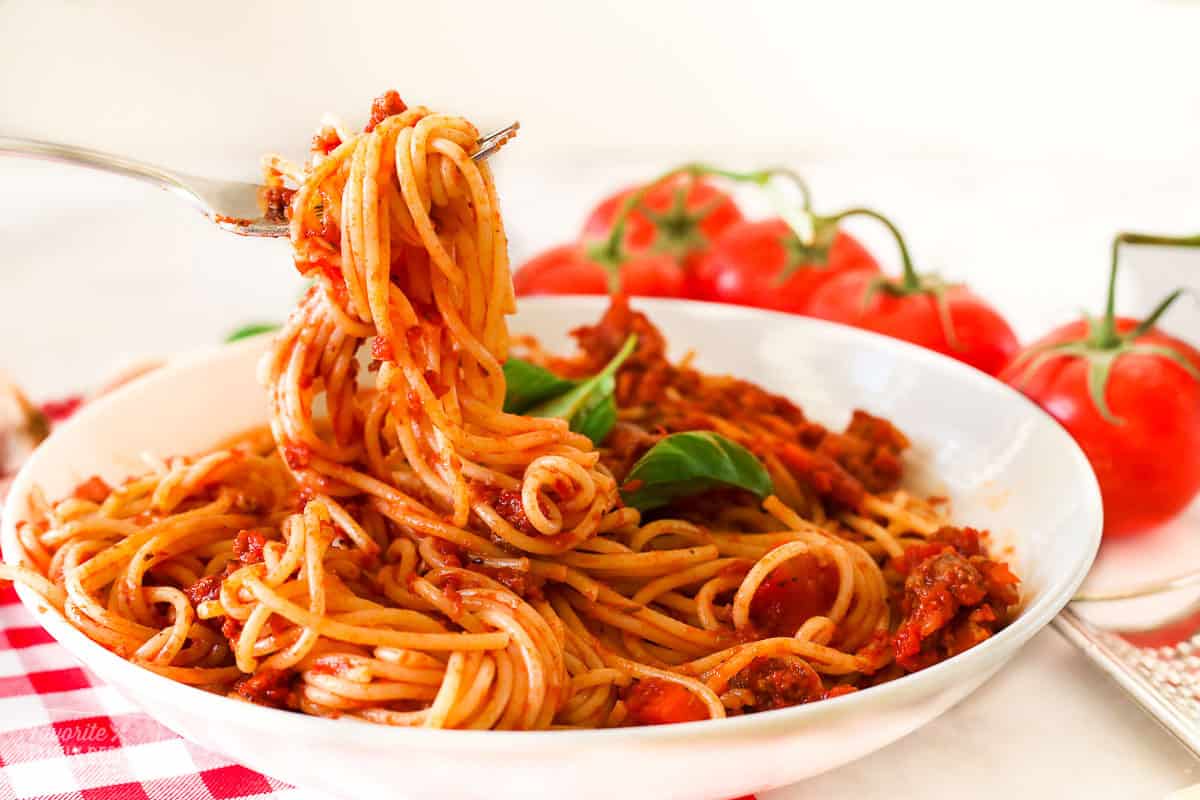There are lots of spaghetti recipes out there, but traditional Italian spaghetti is what started it all. Italian spaghetti is one of those amazingly delicious pasta recipes that stays with you.
The red marinara type sauce has layers of deep rich flavor tempered with plenty of authentic Italian seasonings, but it doesn’t stop there! You’ve got the hint of creamy cheesy goodness and plenty of garlic tempered with slightly sweet undertones that make you crave more.
Forget those processed jars of paste and throw together a beautifully delicious Italian spaghetti sauce made from simple wholesome ingredients! Looking for more delicious spaghetti recipes? I hope you’ll try our TikTok spaghetti, chicken spaghetti, million dollar spaghetti, and Mexican spaghetti next!

Storing + Freezing + Make-Ahead
- How Long Can You Keep This In The Fridge? Your yummy spaghetti sauce will stay good in the fridge for up to 4 days when stored properly. The best part is that the intense flavor will continue to develop into something even more incredible as it rests in the fridge!
- Can You Freeze This? Yes and no. This Italian spaghetti sauce freezes really well and the flavor continues to develop as it thaws. You probably don’t want to freeze the pasta, or you’ll end up with a mushy mess. Pasta just doesn’t do well in freezing temperatures.
- Make Ahead Tips: This decadently delicious Italian pasta recipe is one that I always like to have on hand, especially during the holiday season and cold winter months. I like to make up a couple of batches of the sauce and toss it in the freezer as soon as the leaves start falling. I know I’ve got plenty of holiday cooking in the future and it just simplifies things to have this yummy sauce ready-made and in the freezer!
How about my classic tiramisu or strawberry tiramisu for dessert!
What I Love About Italian Spaghetti Recipe
I love that this Italian spaghetti is so super simple to throw together, but it produces some intensely vibrant flavor. I never knew how easy it was to reproduce the rich aromatic flavors from Italian restaurants. I just love sharing this recipe! Here are some of its best qualities
- Quick easy prep
- Wildly delicious Italian flavor
- Simmer time lets you get other things done
- Wholesome pasta meal
- Easy break from holiday leftovers
Making this awesome Italian spaghetti sauce starts with simple wholesome ingredients, which is the beauty of this recipe. No bland pasta sauce from a jar for this trendy mama! Here’s what you need.
- Tomato – You’ll be using crushed tomatoes and tomato paste to create this incredible recipe. This is where it all starts!
- Alliums – Minced garlic and grated onions help blend savory and slightly sweet for a balanced flavor profile. Besides, you can’t make spaghetti without garlic and onions!
- Spices – Lots of vibrant Italian spices make this spaghetti sauce intensely delicious. The delicate combination of rosemary, bay, and Italian seasonings brings the flavors of Italy right to your kitchen!
- Sugar – This recipe calls for brown sugar instead of white. Be sure to pack your brown sugar when measuring it out. The molasses gives your recipe a deeper more complex flavor instead of making it sugary sweet. It’ll just have those slightly sweet undertones that are oh-so-good!
- Pasta – Cooking your pasta just until al dente will keep it from getting mushy. It should still be just a little firm in the middle. You’ll also want to reserve some of the starchy pasta water after it has cooked, just in case you need to thin your sauce.
- It’s also important to sauce your pasta immediately. Don’t rinse it. The hot starch will help the sauce stick to the pasta and evenly coat it for the savory saucy flavor in every bite!
- Cheese – You can’t make an Italian spaghetti recipe without parmesan cheese!! Instead of sprinkling it on top, this grated parmesan goes into the pot with the sauce to help create that rich creamy texture.
There’s no need to make this delicious Italian spaghetti recipe vegetarian style because there’s no meat in it! That’s one of the reasons the prep is so incredibly simple, but the awesome Italian flavor doesn’t disappoint! Here’s how to coax it out.
Using a heavier gauged pot works best for this recipe because it helps distribute heat more evenly. You don’t want scorched sauce on the bottom of your pot, it’ll contaminate your whole dish!
Toss all ingredients in your pot except the spaghetti pasta and parsley. You’ll want to incorporate ingredients well and bring them just to a boil before reducing the heat. You’re looking for a gentle simmer over medium-low heat that barely bubbles. It’ll help build that lovely Italian flavor while protecting the integrity of your sauce.
Discover how the best quality spaghetti is made | Pasta Grannies
FAQ
What is spaghetti made of in Italy?
Does authentic Italian spaghetti have meat?
What is the difference between American spaghetti and Italian spaghetti?
What is real Italian pasta made of?
